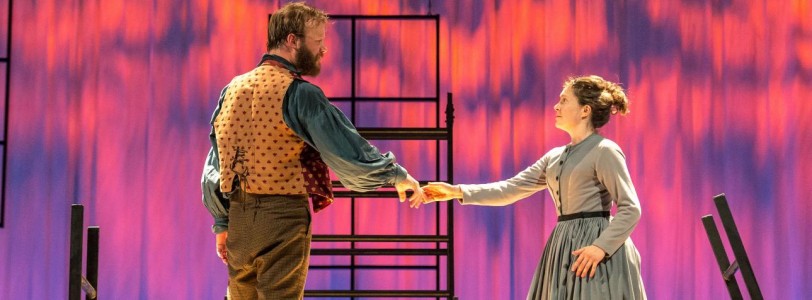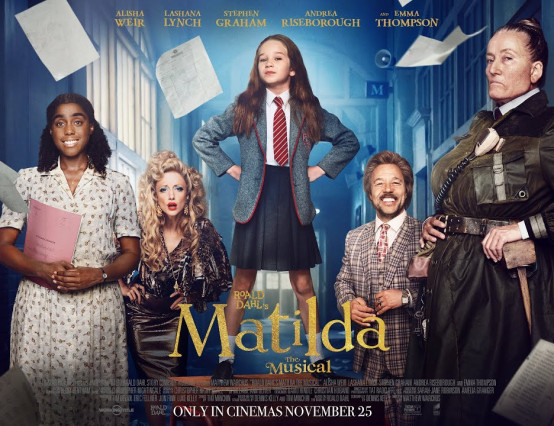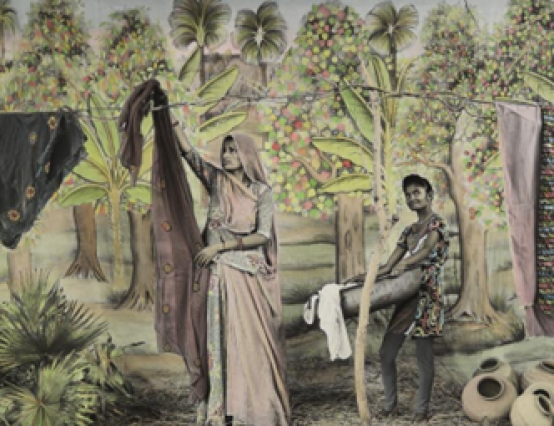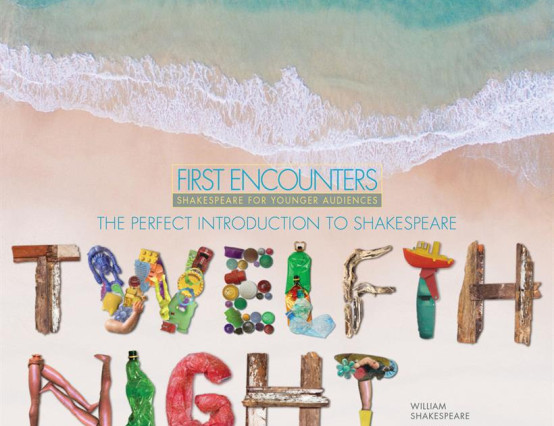Sally Cookson’s adaptation of the Charlotte Brontë 1847 novel, Jane Eyre ran from 17th September 2015 to 10th January 2016 at the National Theatre. For those who did not see this production however, a recording of the performance was recently put onto YouTube where it received many positive reviews.
The set designed by Michael Vale was made up of exposed wooden structures, metal ladders, white sheets around the end on space and a bare wooden floor. While initially difficult to follow due to the changing location and unconventional shape, over the course of act one a clearer map was formed of Thornfield Hall though the repetitive movement from Jane’s room- a wooden platform stage left, down the corridor and stairs to the open space downstage which would change in function to allow the story to continue with very few pieces of set or props. I believe this worked well as Vale not only took advantage of the limited space but also showed Jane’s non-materialistic nature as she travels around with little but herself and her dignity. Occasionally, pieces such as an arm chair to distinguish Mr Rochester from the other characters or windows to show Jane’s confinement were used but these complimented the simple set well. One part of the stage which stood out was the coffin shaped trap door downstage which would open to take in characters who die throughout Jane’s life. While I enjoyed the use of this in combination with smoke and lighting changes, which were designed by Aideen Malone, the use of this was inconsistent; while being used for Jane’s uncle and childhood friend Helen, it was not used for her parents or Bertha where it would have been appropriate.
At the opening to the play, choral speech and movement was used very well by the whole cast, particularly the repeated use of the words “It’s a girl”, at this fast-paced point there is a lot of energy, which is gradually lost as Jane, played by Madeleine Worrall, settles into Thornfield Hall. The multi-rolling done throughout was very strong, notably when at Lowood School, cast members all in uniform would break out of the timid obedient formation to become the harsh teachers of the charity children. This was done so powerfully that the only costume change needed was a large black hat, contrasting with the rows of grey bonnets. Choral movement was also used well at Lowood in the morning sequences where the girls would all perform the same actions to highlight the strict and regimented nature of life at this school.
As there was no orchestra pit, the band performed on stage amongst the set the whole time, led by Benji Bower. This brought more significance to the range of musical styles in the play, such as jazz and folk and highlighted Cookson’s idea that “music was going to play a very important part in the production”. I would agree as well with her that the placement of these performers was “not a distraction”, however the use of three songs which were not original to the play I found somewhat distracting as recognising a slowed down acoustic version of the song Crazy by Gnarls Barkley distanced me from the story as the 2006 song felt out of place, despite its alterations. Having said that, the performance of this song was still very emotional and all of the music was well executed, as well as the sound effects, such as horse shoes when Jane would travel in a carriage, which worked well live due to the precision and effective build-up of sound created.
All of the costumes, which were designed by Katie Sykes, were appropriate to the early 19th century Worrall’s costumes particularly help to tell the story of Jane’s life, from the white gown she wears at the beginning of the play, serving as a pure, innocent version of herself, as well as a ghostly presence watching her early life go by and immediately distinguishing her from the other characters as the focus. I thought the uniformity of her voices showed them all as one body of Jane’s thoughts and allowed them to remain fairly neutral in scenes, such as when Mr Rochester promises to reveal his secrets to her once they’ve been married for a year and a day.
The story ends as it began with the words “It’s a girl”, in reference to Eyre and Rochester’s child, However; a cyclical structure did not necessarily make for a satisfying end. I felt a lack of a sense of redemption for Rochester, even though his final heroic acts are reported to the audience. There is also no understanding of the reconciliation between him and Jane after his repeated lies. This may be because we don’t hear from him, we are just shown and told what happens next, perhaps having some dialogue between these two characters at this point could have made the story feel more concluded.
While I enjoyed many aspects of this production, after 3 hours the story of Jane Eyre did not leave me feeling satisfied. There were many excellent aspects of the production, such as the set and costume, however the story itself did not sustain my interest throughout and in particular towards the end of the play.









Very intelligent and interesting ideas about the set and interpretation of the play :)